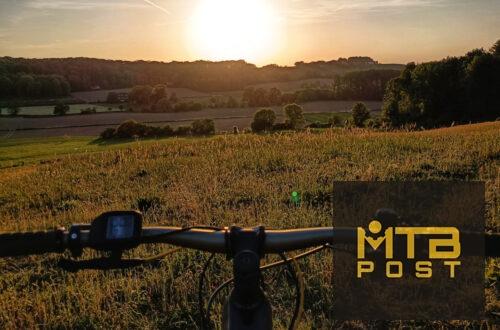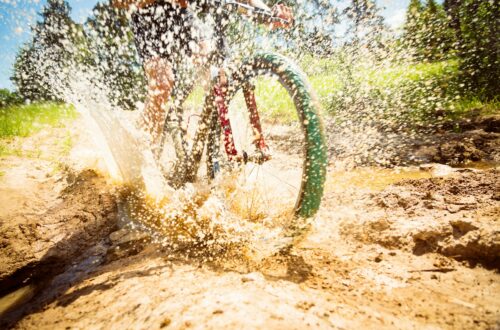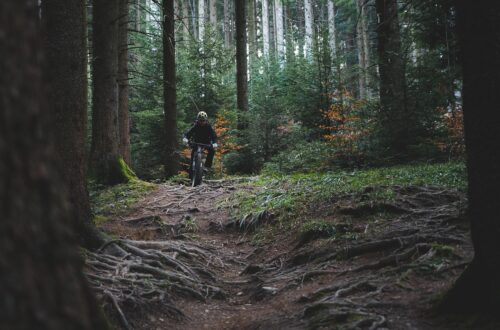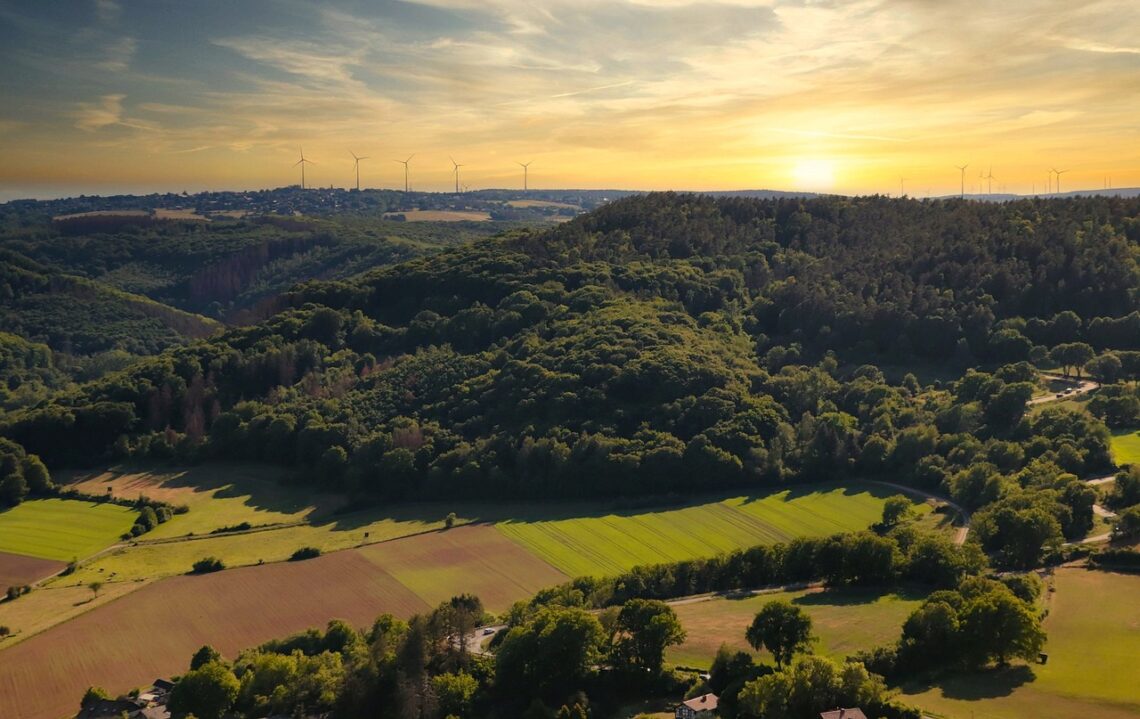
Mountain Biking Around The Nürburgring
If you happen to be a somewhat of a car/motorsport enthusiast, you’ve most definitely heard of the Nürburgring or Nordschleife; a beautiful 21 km long twisty racetrack through the Eifel region in Germany. But as a mountain biker, can you combine the two and do some mountain biking around the Nürburgring?
Mountain biking around the Nürburgring is a great way to explore the track whilst getting a workout. The Radarena Am Ring BULLS Hölle Tour 1 brings you around the complete Nordschleife and shows you all the great viewing points of the track. The trail has length of 24 km and it takes about 3 hours to complete it.
I’ve been going to the Nürburgring for many years now, and I’ve found the perfect trail for you to enjoy! I will also provide you with some tips to make your trip as safe and convenient as possible.
What’s The Nürburgring Or Nordschleife?
For those that are not familiar with the Nürburgring, here’s a quick summary of what this place is all about.
History of The Nürburging
In 1927 the construction of the racetrack ‘Nürburgring’ was completed and used for official races. In the evenings and weekends it became a one way toll road for the public; everyone with a street legal car could now drive the track (Touristenfahrten). In 1929 the track got split up in two parts: the longer Nordschleife for main events like Grands Prix, and the shorter Südschleife for motorcycles and smaller events.
In the following years, many important races like Formula 1 were held on Nordschleife. But as F1 evolved, it became clear that the track was too dangerous for faster cars and a lot of accidents happened. It was in this period that the track got its nickname: the Green Hell. In 1976, the last F1 race was held on the Nordschleife. The track was too long, too narrow and after all the adjustments that already had been made, it would become too expensive to change the track to meet the current regulations. The Südschleife had been neglected for all these years and was abandoned somewhere in the 1970’s.

To meet the latest safety standards, a new track was built next to the Nordschleife. The Nürburgring now also consisted of a Grand Prix track. It was used for many big international events and even Formula 1 for some time. Both tracks can be combined or separated from each other. When combined, the Nordschleife and Grand Prix track is more than 28 km long.
Today, the Nürburgring still gets used for official races and tourist drives. Every weekend from March till November, it’s a well visited area with visitors for either a race or Touristenfahrten. One of the most visited yearly events, is the 24 Hours of Nürburgring and Carfreitag. At other times, the track gets also used for production car development: the industry pool. Car manufacturers put their new cars through their paces to collect data under heavy conditions. Throughout the year, many new (and camouflaged) cars can be spotted on the track.
Visiting The Nürburgring
Whether you’re into race cars, road cars or motorcycles, you can have a great day at the Nürburgring. Just check the Official Nürburgring website so you know what’s on. Although it can be very busy at times, there’s is a chill vibe.
The Eifel is a low mountain range in the west of Germany with mountain chains up to 700 meter. Although the racetrack is well known, it’s actually quite remote. There are no motorways or an airport nearby, and public transport is very limited. To get there, you have to travel over a fair amount of mountain roads. Which is actually not a punishment at all…
There are no big cities nearby. The main villages in the area are Nürburg and Adenau. Fun fact: Nürburg actually lies within the track; you pass a bridge when you’re heading in that direction. Within the two villages are a few restaurants, supermarkets and lots of hotels and B&B’s. In the industrial area you’ll find mainly motor sport related companies. During the off season it gets very quite with not much to do.
If you are a tourist and you’re just visiting the area, it is not a very expensive day out. Of course, if you want to drive the Nordschleife yourself or if you want to spectate at an official event, than that’s a different story. Other than that, the 21 km long Nordschleife is free to visit and you can spectate from a few viewing spots. Eating and drinking in the area is reasonably priced.
Mountain Biking Around The Nürburgring
Although this region is very car-focused, the beautiful Eifel has a lot more to offer. There are for example some very good hiking trails in the area. Hiking is basically an obligation for anyone who wants to visit the best viewing spots. There’s no way around it since the highlights are not directly located next to the road and usually uphill.
When visiting, you will come across a lot of mountain bikers as this is a great way to explore the area and spend your spare time. It doesn’t really matter if the track is open or closed; the ‘Ring is definitely a magical place to be and a great opportunity for taking some beautiful photos.
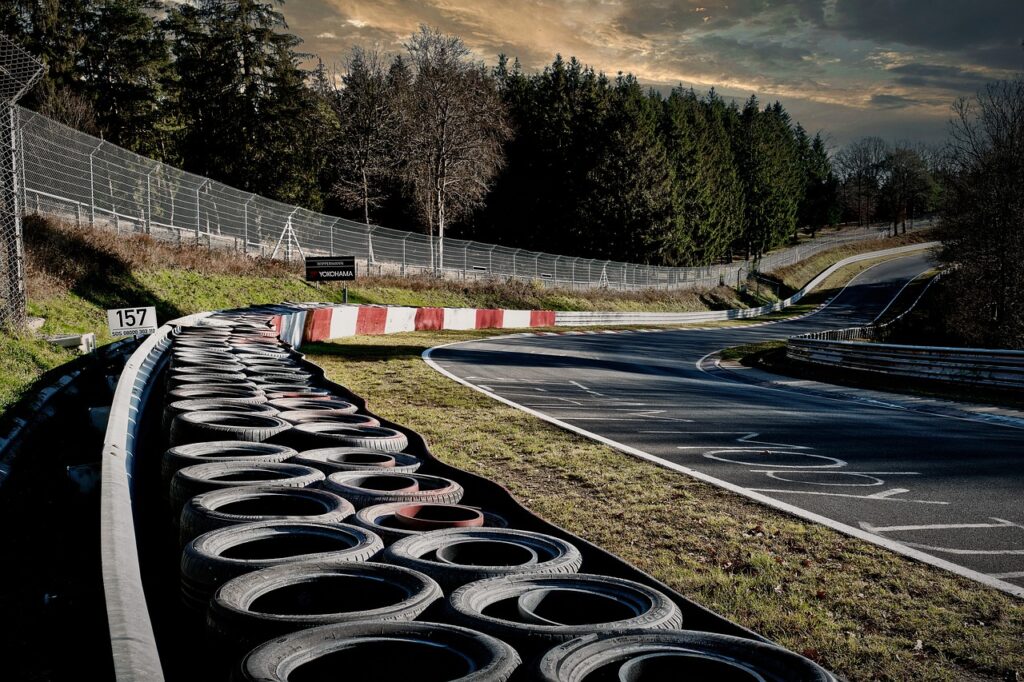
Radarena Am Ring Bulls Hölle – Tour 1
There are quite a few mountain bike trails in the Eifel region. But the best way to combine the action of the Nürburgring with some physical exercise on a bike, is to ride the Radarena am Ring Bulls Hölle Tour 1 around the circuit.
Some stats:
- Length: 24.3 km (15.1 miles)
- Duration: 3 hours
- Ascent: 476 m (1562 ft)
- Max gradient: 27%
- Difficulty: Difficult
The rails runs completely around the Nordschleife and you’ll get as close to the track as possible. The green waypoint is bike shop Radsport Breuer in Adenau and marks the start of the route. Since the route is marked, you could start your journey anywhere your like. You’ll pass a lot of great viewing spots where you can catch a breath. When you’ll enter the village of Nürburg, it’s worth visiting the Nürburg castle ruin (red waypoint). For a small fee you can walk on the remains of this 12th century castle and look over the area.
The blue waypoints along the route, mark some great spots for viewing track action. They can be fast sections like Schwedenkreuz or technical corners like Wehrseifen.
This sign marks the route

Cycling On The Nürburgring
Walking or cycling on the Nürburgring is forbidden. But a few times a year, the Nürburgring is open for cyclists: Rad am Ring. This literally means that you can enter the track with your own bike! It doesn’t matter if you own a road bike, mountain bike, regular bike or e-bike.

It is a great way for getting a feel for the track from a different perspective. With height differences of up to 300 meters, this is definitely not a walk in the park and can be quite demanding for the less fit riders. You can go on the Nordschleife as well as the Grand Prix track. Check the official website of the Nürburgring for the data and regulations.
Things To Take In Consideration When Mountain Biking Around The Nürburgring
Before making the trip to the ‘Ring, there are a few things to take in consideration.
Ever-Changing Weather
The Eifel region is known for it’s ever-changing weather conditions. Because of the mountain range, it’s very difficult to predict the weather for this area. It is possible that it’s raining in one part of the track and completely dry and sunny in another part at the same time. This makes it especially treacherous for drivers of the Nürburgring.
If you’re planning on mountain biking around the Nürburgring and the weather forecast predicts that it’ll be a sunny day with a slight chance of rain, be prepared for heavy rain.
Public Roads Are Unsafe For Cycling
Riding a bike in this area might be quite different from cycling in your own country. There aren’t many cycle paths which means that you have to use the public road. This is completely legal, but not very safe with other road users passing you at high speeds. Keep in mind that the Nürburgring attracts a lot of motorcycle and car enthusiast, which like a bit of sporty driving on the mountain roads. This can make it quite intimidating for cyclists.
The mountain bike trail Radarena am Ring Bulls Hölle Tour 1 does have a few sections where you cross or ride on a public road. It is advised to carry lights to let other road users know that you are there.
Helmets Are Mandatory
Many people think that a helmet is mandatory in Germany, because almost every cyclist wears one. But it’s actually an unwritten rule. You are obliged to wear a helmet on road bikes, mountain bikes and speed-pedelecs (e-bikes which go faster than 45 km/h), but not on a regular bike.
Whilst it is a stupid idea to not wear a helmet when mountain biking, I want to emphasize that you should definitely wear one in the area of the Nürburgring.
Renting A Mountain Bike
When you want to go mountain biking in the area, it is not necessary to bring your own bike. The benefits of not having to bring your own bike, is that you don’t need a big car or a bike rack. It is also a great opportunity for testing out a new bike like an e-mtb. There are two places nearby where you can rent electric as well as regular mountain bikes, such as Radsport Breuer and Bikepower E-bike Store.
The hills near the Nürburgring can be quite steep. If you are new to mountain biking or not very experienced with climbs like these, then I would definitely advise you to bring or hire an electric mountain bike. It will make your day so much more enjoyable. More on electric mountain bikes in my article: Are Electric Mountain Bikes The Future?.
Frequently Asked Questions
Can You Rent A Mountain Bike At The Nürburgring?
You don’t have to bring your own mountain bike to go for a ride around the Nürburgring. There are a few bike rental companies in the area such as Radsport Breuer or Bikepower E-bike Store in Adenau.
What Does It Cost To Visit The Nürburgring?
You can visit the Nürburgring for free. Especially during Touristenfahrten (tourist drives), there are no costs involved in spectating from one of the viewing spots. Fees are charged when you want to drive the Nürburgring yourself or spectate during an official race.
Are Helmets Mandatory For Mountain Biking In Germany?
Wearing a helmet on a mountain bike is obligatory in Germany. This rule also goes for road bikes and speed pedelecs. For regular bicycles it’s not mandatory to wear a helmet, but it is advised.



